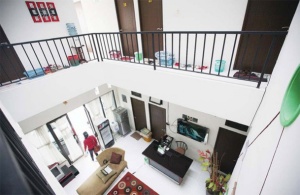For ‘kos’-owners: no pain no gain
With the high demand for inner-city housing from office workers, owning and running a kos (boardinghouse) might seem like a lucrative business.
But owning a kos is nothing like the traditional landowner who sits idly and has the rent money pour into his bank account. Maria M. Limaningsih, 56, a kos-owner in Jakarta, understands the difficulties. “People think that owning a kos is convenient and easy,” she said. “But it’s a difficult job,” she said.
Having successfully run two boardinghouses for students in Surabaya, the nation’s second largest city, with a total of 40 rooms, Maria saw the business potential of owning a kos in the capital. She bought an old house on a 300-square-meter site in Setiabudi, Jakarta and converted it into a three-story boardinghouse with 20 rooms, she has called it Griya Amartha.
Maria hired a contractor to design and construct her boardinghouse; a designer for the furnishing; a brand managing company to find a name and logo for her house. She spent a total of Rp 4.7 billion (US$492,000). She charges Rp 3 million a month for a nine-square-meter room with air-conditioner, WiFi, cable television and an ensuite bathroom with hot-water.
“But it’s very troublesome,” she said. She outsources a receptionist and security guards as well as a valet parking attendant. “The parking space is in the basement and it’s difficult to park, so I hired a valet”. She also hired four domestic workers to do the laundry and clean the rooms.
“I have to be on call, if the air-conditioner breaks down, or the water doesn’t run,” she said. She also has to pay for the electricity. “And you can’t tell people not to use too much electricity.”
But it pays, she said, taking home Rp 49 million every month after expenses.
Apartment owner Amin Cheng said he no longer had the patience to run a boardinghouse. He used to have a 17-room boardinghouse for students in Kemanggisan, West Jakarta. “There are always problems of leaks or the water pump not functioning. There are a lot of things to handle,” he said.
Moreover when the government progressively increased the price of electricity, Amin decided to sell his boardinghouse. He has chosen to invest in condominiums and rent them to high-earning families.
There is no exact data on the number of kos in Jakarta. Requests for an interview with the Jakarta deputy governor on housing affairs have not been answered. However, in 1987, the city passed a bylaw on boardinghouses. It obliges kos owners to register their boardinghouses and to report the identity of tenants for registry purposes. Compliance with this bylaw however is questionable at best.
Both Amin and Maria said they did not register their kos despite the bylaw.
Maria said that in her area, it was left up to the individual so she did not feel it was necessary to report even to the local neighborhood leader (RT). “But I do keep a log of the tenants’ identities,” she said.
— Prodita Sabarini
The Jakarta Post | Reportage | Wed, September 26 2012

